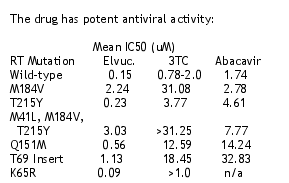 |
 |
 |
| |
Elvucitabine (ACH-126,433, L-Fd4C)
Reported by Jules Levin
|
| |
| |
John Pottage from Achillion Pharmaceuticals reported the findings from this proof of principle pilot study. This new drug is an L-nucleoside analog with potent antiviral activity against hepatitis B and HIV. In vitro the drug has been 10-20 times more potent than other nucleosides. IC50 levels (enough to suppress virus) against HIV-resistant virus are achievable in plasma. Clinically, the drug has shown potent activity against HBV (5-20/mg/day). It's dosed once daily with a single pill. Intracellular half-life is >20 hours. The drug's structure suggests it may have reduced likelihood for long-term mitochondrial toxicity.
Elvucitabine (ELV) has potent activity against 3TC resistant virus. This study was designed to assess the anti-HIV activity and safety of ELV in a HAART regimen that in patients with the 3TC M184V mutation. Patients remained on regimen and switched out 3Tc for one of 2 doses of ELV. As you can see the results below, the drug showed antiviral activity but the study was stopped prematurely due to toxicities. Four patients had serious adverse events and several patients had rash. Pottage said lower doses will be considered.
56 patients initiated therapy in the study and 44 completed 4 weeks. 12 patients discontinued early due to:
--4 due to adverse events
--6 due to study closure
--2 lost to follow-up
The study was closed March 2003. 59% of patients in study were White, 23% Black, 16% Hispanic. The mean duration of HIV treatment for the study patients was 6 years and 25% had a history of HIV-treatment complications.
Average viral load reduction after 28 days of receiving drug was 0.67 for the patients receiving 50mg of ELV ans 0.78 for patients receiving the higher dose of 100mg ELV. CD4 count declined for patients receiving ELV.
ADVERSE EVENTS. Pottage reported that the drug was generally well tolerated with few mild-moderate clinical adverse events:
--mild headache and gastrointestinal distress similar in all treatment groups
--4 patients (3 in 50mg group, 1 in 100 mg group) with mild to moderate maculopapular rash which resolved with drug discontinuation
SERIOUS ADVERSE EVENTS. Bone marrow suppression was experienced by 4 patients in 100mg group and 2 patients in the 50mg group. Most occurred between third and fourth week of therapy. No clinical events were associated with the bone marrow suppression. The bone marrow suppression was dose dependent and affected white blood cell (WBC) and ANC, and was reversible upon drug discontinuation.
10/20 patients receiving 100mg dose and 6/24 patients receiving the 50 mg dose experienced a decrease of 2,000 white blood cells or more. 3 patients in 50mg group and 3 in 100mg group experienced decrease of 1500 to 2000 cells. 4 in 50mg group and 3 in 100mg group experienced 1000 to 1500 decrease in cells. And 4 patients in 50mg group and 0 in the 100mg group experienced decrease of 1000 or less cells. No patients in the 3TC group experienced decrease in WBC of greater than 1000 cells, although 4 patients receiving 3TC experienced decrease of less than 1000 WBCs.
|
|
 |
| |
Abstract:
BACKGROUND: Elvucitabine (ELV) is an L-nucleoside analogue with potent in vitro anti-HIV activity, particularly against strains with resistance mutations
to numerous other drugs, including nucleosides, all non-nucleosides (NNRTI) and HIV protease inhibitors (PI). ELV exhibits reduced potency against strains harbouring the M184V mutation [lamivudine (3TC)-resistant], but the inhibitory concentration (IC 50 ) remains within the range of achievable plasma concentrations. This multicentre study was designed to assess the anti-HIV
activity of ELV in an otherwise unchanged combination of highly active antiretroviral therapy (HAART) in individuals with the M184V mutation.
METHODS: Adults receiving triple, 3TC-containing HAART therapy whose genotype included the M184V mutation were eligible; full genotypic profiles were available for each subject. Subjects had HIV RNA levels of 1000-30000 copies/ml and CD4 counts >200 cells/µl. Minimum baseline safety parameters were required, together with stable clinical disease and no active AIDS-defining conditions. Subjects were randomized to receive blinded ELV 50 or 100 mg/day or continued 3TC 300 mg/day in a ratio of 25:25:10, while continuing the other two agents of their HAART regimen. Subjects were treated for 28 days; HIV RNA
and safety determinations were measured weekly. Open-label ELV was available for subjects who wished to continue ELV after the 4 weeks.
RESULTS: Fifty-nine subjects were randomized, 56 initiated treatment and 44 completed 28 days of therapy. Mean age was 43.5 years (range 21-65), mean CD4 count was 471 cells/µl (range 120-960) and mean plasma HIV RNA level was 10300 copies/ml (range 120-75000; Roche Amplicor 1.5 assay). Prior anti-retroviral therapies included all commercially available agents. HIV genotypes (HIV Genosure) revealed =/>one primary nucleoside resistance mutation (in addi-tion to the required M184V) and primary resistance mutations to either the entire class of NNRTIs or PIs in all subjects. Potent anti-HIV activity was observed in both ELV groups: mean declines at 28 days of -0.67 and -0.78 log 10 copies/ml in the 50 and 100 mg groups, respectively, as compared with an increase of +0.01 log 10 copies/ml in the 3TC group (P<0.0001 for both comparisons). Baseline genotypes were not clearly correlated with antiviral activity. Myelosuppression was the only study-related adverse event observed and was generally associated with the ELV 100 mg dose group.
CONCLUSIONS: ELV demonstrated potent anti-HIV activity in patients with multidrug-resistant HIV, comparable or superior to other potential Ôsalvage' therapies, with a convenient single daily oral dose. Doses of 50 and 100 mg/day were similarly potent; the safety profile of 50 mg daily was more desirable than 100 mg. Further study with doses up to 50 mg daily is war-ranted
to identify the optimum dose for long-term clinical development of ELV in this population with limited treatment options.
|
|
| |
|
 |
 |
|
|